Justin Ming Yong is a Toronto-based artist whose quilt-making practice explores an unconventional, modern approach in an otherwise classically folk-art medium. He examines the relationships between bold colour theory, dissymmetrical shapes and mixed fibres to disrupt expectations and create pieces that are layered and multi-dimensional. However, despite his devotion to the contemporary, he is far from dismissive of tradition, often incorporating and reflecting on heritage and legacy in his work. Yong considers his own ancestry through themes of forgotten landscapes, cherished foods, and exploited histories by practising a family tradition of quilt making.
From what I gather you didn’t have a lot of experience quilting before learning it during the pandemic. I want to start by asking about heritage, because your mom quilted when you were younger. Did that register for you, and did you have any relationship to it before learning it yourself?
⎯⎯⎯ Growing up, she was always making them on and off. Obviously, I saw her doing it, and it was there, but I was never really interested. I never really liked it. She was always sewing all kinds of things, like figure skating dresses, or things she would sell at craft shows – and she still sort of does. I wouldn’t say I hated it, but I really didn’t like it, and it did nothing for me, especially thinking about it as an art form. I just had the basic stereotypes that most people have about quilting. It’s been changing a lot recently. Having conversations with people, they’re always talking about this moment that quilting is having, or textiles in general, but back then I just didn’t see it. I was so tunnel visioned. Art for me was more photography and skateboarding. Making videos was the artform I was introduced to aside from drawing and painting as a child.
Was there a definitively masculine or feminine thing about those art practices and the division of labour?
⎯⎯⎯ Probably. At the back of your mind, I think so, especially growing up in a smaller town. That stuff is a little more prominent.
Where did you grow up?
⎯⎯⎯ I grew up in a small town, a couple hours outside of Toronto, close to Lake Erie. I grew up in a small town called Townsend, there’s maybe 600 people. It’s basically an intersection. It’s like a subdivision dropped in the middle of a farmer’s field. There’s no gas station, no corner store, there’s literally nothing.
Growing up in this small community, were you attracted to skateboarding and other forms of urban expression through magazines and other media?
⎯⎯⎯ Thinking back to those days, I wanted to be a city kid. I wanted to skip school and go to the mall. That was the dream. Everything we knew was from magazines. That was back when you’d hang out and you’d bring it to show your friends. I was fortunate enough because my family would take trips to Toronto. In the summer more often, but basically once a month we’d come in, go to Chinatown, get dim sum, my parents would get chinese groceries, and then we’d go to the skate shop and I’d get a video. It’s crazy thinking back to it, it was like fifty bucks, and we’d just watch it non-stop. Again, sharing it with your friends, you’d hang out and watch it over and over. I think a lot of people have the same memories, especially people who experienced a lot of culture through skateboarding.

It’s very communal, because it was still very niche, but expanding and becoming more mainstream. So, when did the world of videography and skateboarding become a form of artistic expression?
⎯⎯⎯ Maybe 12 or 11. It was one of those things that, looking back, you thought was going to be the future, even though you’re terrible at all of it.
Did you go to art school? Was that the next step for you?
⎯⎯⎯ I wanted to do photography from an early age. I remember having a meeting with my guidance counsellor in grade nine – again, it was a very small highschool – and she asked me what I wanted to do. She would set kids up with classes for the future, and I remember I said I wanted to be a photographer and she had this look and said “oh, we don’t really have anything for that.” I could take general arts though, so that was the route I took. There was one art teacher, and me and the teacher didn’t get along, so that was it for art education in highschool. Then I guess I just tucked it away, and eventually went to college for a very technical photography program, but that was a little later. There was a large gap where I wasn’t really doing much.
What was the impulse to revisit photography?
⎯⎯⎯ In the back of my mind I wanted to do this originally, so why not just do it. I didn’t want to be a skate photographer or anything, I just wanted to do photography. Weirdly enough, When I took a year off after highschool, I didn’t think I’d do any post-secondary education, so I was going to go to school to become a welder, which at the last minute I didn’t do.
The sliding door.
⎯⎯⎯ Exactly. Looking back on it now, it actually could have been nice.
It would have been a different life, but the welding and the quilting are both additive processes. Maybe welding would have been an outlet in a different way.
⎯⎯⎯ I still think about it, especially recently, it would be a nice skill to learn. I don’t know why I had it in my head. My uncle was a welder, so maybe I took him as inspiration. I do think about it like that, it’s essentially patchwork at the end of the day.
There’s something elemental about welding, like you’re on the edge of danger.
⎯⎯⎯ Compared to a sewing machine!
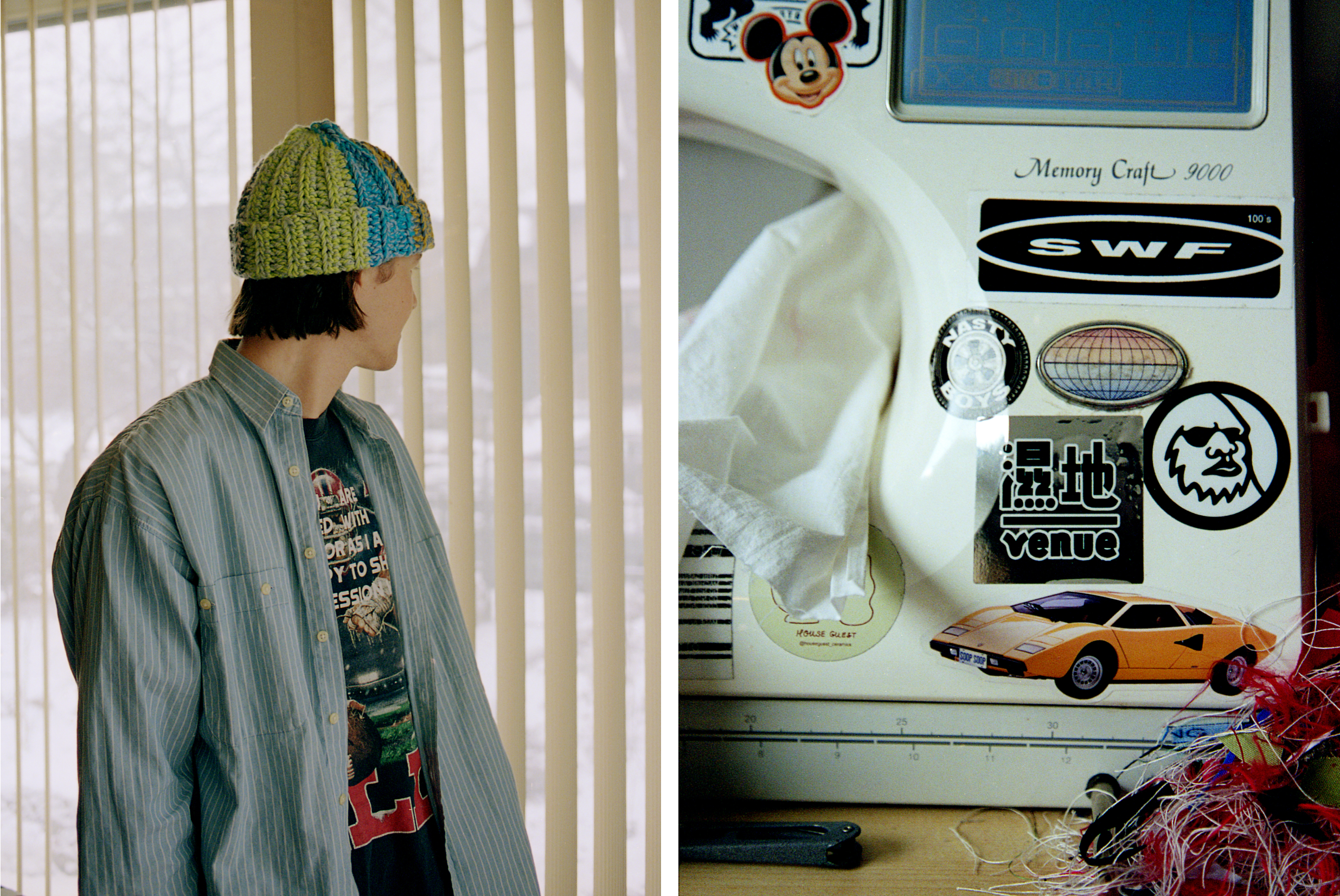
It’s interesting you mention your uncle was a welder and your mom was into quilting. There’s a psychological theory that in many ways we become our parents. We can’t help it in some ways. I wonder what you felt when you approached it during the pandemic after kind of ignoring it for most of your life?
⎯⎯⎯ I always thought when I was younger, even nineteen or twenty, that I was so different, but as you grow up you find yourself doing little things that are just like your family – these small moments. For example: growing up, I’d be sitting on the couch and I’d have a cup close to the edge of the table, and my dad would come over and push it in like ‘be careful’, and now I find myself doing the same thing. It does happen. We’re definitely shaped that way.
Was it something that you were resistant to, the quilting, as it became your own art form?
⎯⎯⎯ I think I just let it happen. I got a little worn out working in photography so much, for the past 10 years or so. We’re constantly looking at images; with social media, advertising, public transit; everything is image based. I felt like I couldn’t contribute anything new, I guess. So I wanted to explore a new medium. Seeing the book Great American Quilts, and having a lightbulb go off, and realizing I can create this abstract imagery through a new medium and have different elements to it like texture and movement. It is something familiar from my past and it could be accessible to me. One of the big moments, also, was moving into a new apartment and having the space to do it. That opened up a new door to what’s possible.
Were the first attempts to quilt difficult or frustrating, or did you immediately get it?
⎯⎯⎯ I wouldn’t say it was frustrating or difficult. I really enjoyed it, because at the time I started I had nothing but time, so mistakes were fine. Whereas, if I was working non-stop and doing this in the few spare hours I have, then yes, but it felt natural at the time. Obviously it’s something new and things take time, but there was lots of room to experiment as I was learning. I had never really sewn before, so it was a learning curve, but realizing how to attach pieces together and then taking it in all these different directions was nice, and time was available.
Did you gravitate towards the technical elements of it? The quilts now are so expressive and have a freedom to their form and shape, but most quilts look like grids with triangles.
⎯⎯⎯ I think it was a bit like, learn it before you tear it apart. But, I don’t find my work technical, really. People will examine it, and say it is, but I don’t find myself good at sewing. There’s been times where people have asked me to teach them how to sew, but I don’t feel comfortable with that at all. I’ve never sewn a garment or a pattern, but for what I make I know how to do it. Obviously it is technical, but I find that the freedom makes it easier, because even if I sketch something out, it doesn’t have to end up looking like that. My work is very process based.
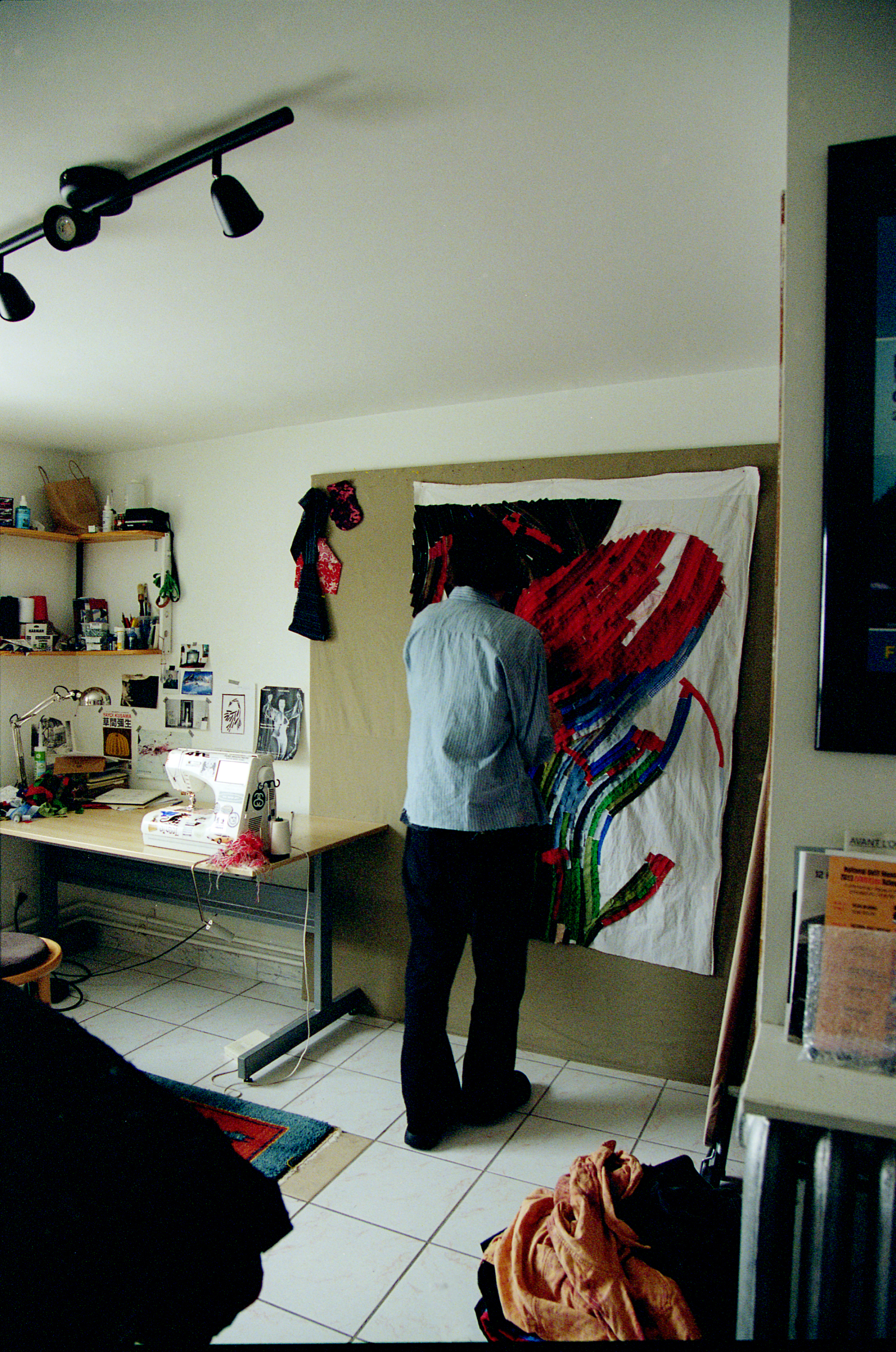
The parallel with photography is interesting, which is also an involved process, from shooting to developing to printing. Were you invested in the process of photography in the same way?
⎯⎯⎯ That was one of the things that drew me in. I used to have a dark room in an old studio, and I really enjoyed that hands-on process. Allowing mistakes and imperfections in is very important, even in the work that I do now. It’s a big part of what I like and I put myself in a situation to be able to get those imperfections and leave room for error, because that’s what I enjoy. Even when shooting film, I don’t do dark room work anymore, and when I’m shooting in a more manual way, a lot of it ends up scanned on the computer, and I try not to spend time on the computer.
Do you still work on photography as part of your art practice?
⎯⎯⎯ I still do a little bit. My main job for years was assisting in commercial photography and doing some of it myself. I always had an art practice on the side. I was really into bookmarking. In terms of making photographic art, I don’t think I’ve made any in years, at least not that I enjoy. I’m letting it simmer in the background. With photography, it ages nicely. You take it, and let it sit for a while, and can enjoy it later.
It’s able to capture moments that you’re not necessarily even sure why you’re taking them, and can look back on it later and understand it better.
⎯⎯⎯ It’s like a selfie. You take it and immediately you think you look like shit, but years later you look at it and it doesn’t look too bad. A lot of the famous photographs, it’s the little things in the photo that make it. A sign in the background, or a building. I can go downtown right now and take a photo of something everyone is photographing, then just take a photo of the street, and the one of the street is going to look better in time. My problem with photography right now is that it’s so accessible and everyone takes so many photos. Those hidden moments are more meaningful given enough time.
I think Roland Barthes in his book Camera Lucida calls that the punctum. What has the most gravitas is the thing that happens incidentally as the photograph is taken. It’s the unintended details that become the subject.
⎯⎯⎯ With my personality type, I’ve always enjoyed finding those moments, because I’m a bit of a shy person. I like to come across those things as opposed to going out and getting them.
When it comes to quilting, the technical aspects are just a way to get to those moments. So, what are the kinds of things that happen while sewing that you would compare to the unintended details in photographs?
⎯⎯⎯ Having a pile of off-cuts and a variety of fabrics on a table and constantly pushing them around and finding these connections and pieces that come together and build towards a colour palette. I think a big one as well is stitching. Quilting is the combining of the three layers: the backing, the top, and the stuffing in the middle. The way I’ve quilted is overtop of everything, in a lot of gridded patterns or shorter strips that create a flow through the piece. They create another dimension on top of it. I always start with the first line and then keep it organic, but it’s not always perfectly straight, and so I build off that first line and it always ends up completely different. I’ve had people recommend machines that automatically create straight lines, but I think that misses the point of what I’m doing. These newer pieces I’m making are scrap strips, and it always starts with one and builds off it, that’s what creates the flow. Maybe one piece has a slightly different width which creates an angle and I just keep building off that.
You’re really responding to the relationship of one thing to another, as opposed to a master plan.
⎯⎯⎯ It’s what I enjoy about it, where it takes you, and using what you have. I’m combining pieces that came from somewhere else, and those relationships build a bigger picture.
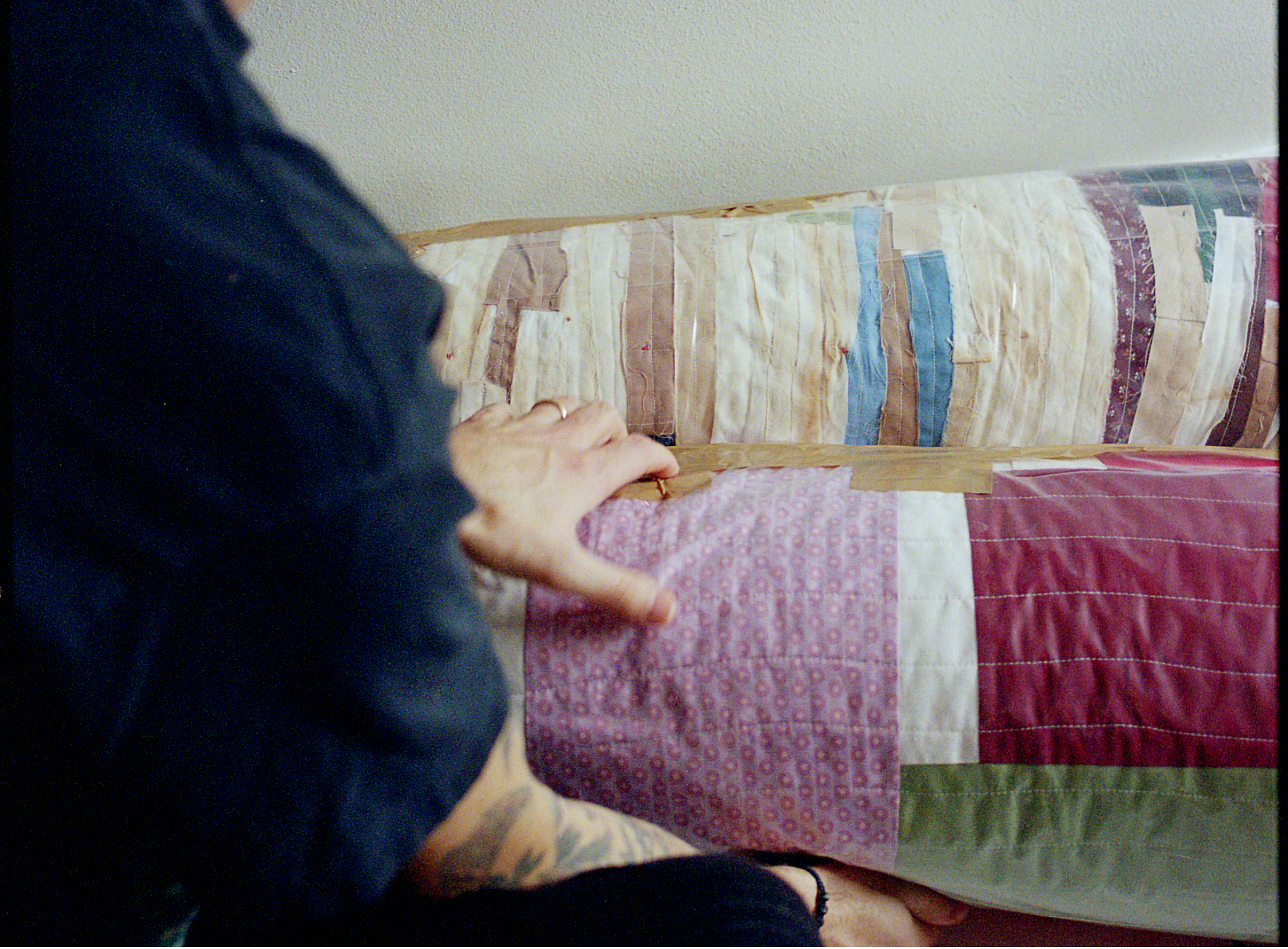
Would you consider yourself a perfectionist?
⎯⎯⎯ Yes. [Laughs] In the weirdest way I guess. Especially when it comes to quilting as a tradition, people might not see it as perfectionism, but I definitely sit there and overthink everything. For me, I’m trying to find something and not always trying to express something literally. I’m finding something through the process.
Are there times where you’re exhausted by an idea?
⎯⎯⎯ Definitely, but then you’ll put a finishing touch on it, and it’s perfect. I’ll sit here for a while and decide whether I’m going to make this one cut down the middle, because there’s not a lot of going back. Those moments may seem frustrating, but that’s what it’s all about. For me, I’m constantly learning from it. So, these decisions can lead you somewhere, and then later you make educated decisions with what you’ve learned. Having to commit to something, and even if you don’t like a decision you made, you can adapt and figure out how you’re going to make it more to your liking.
What are the rules of quilting?
⎯⎯⎯ I’m the wrong person to ask that to [Laughs]. Everyone has their own set of rules. Thinking back to photography, a friend and I always talk about this: you cannot shoot on colour film and make it black and white after. It’s like a moral thing. It’s just one of the rules. For quilting though, for me, I try to take quilting which is a family tradition and push it as far as I can and mix different cultures into it. So, a lot of my work asks what a quilt is. If you’re going to push the boundaries, you have to figure out what a quilt is. The multiple layers stitched together is what a quilt is. Multiple layers held together by a common stitch, that’s the biggest rule.
That’s the foundation.
⎯⎯⎯ But a lot of people might disagree. Last year I had an exhibition at the National Quilt Museum in Kentucky, and most of the guests are quilters, so I read some comments and some of the takes online are pretty funny.
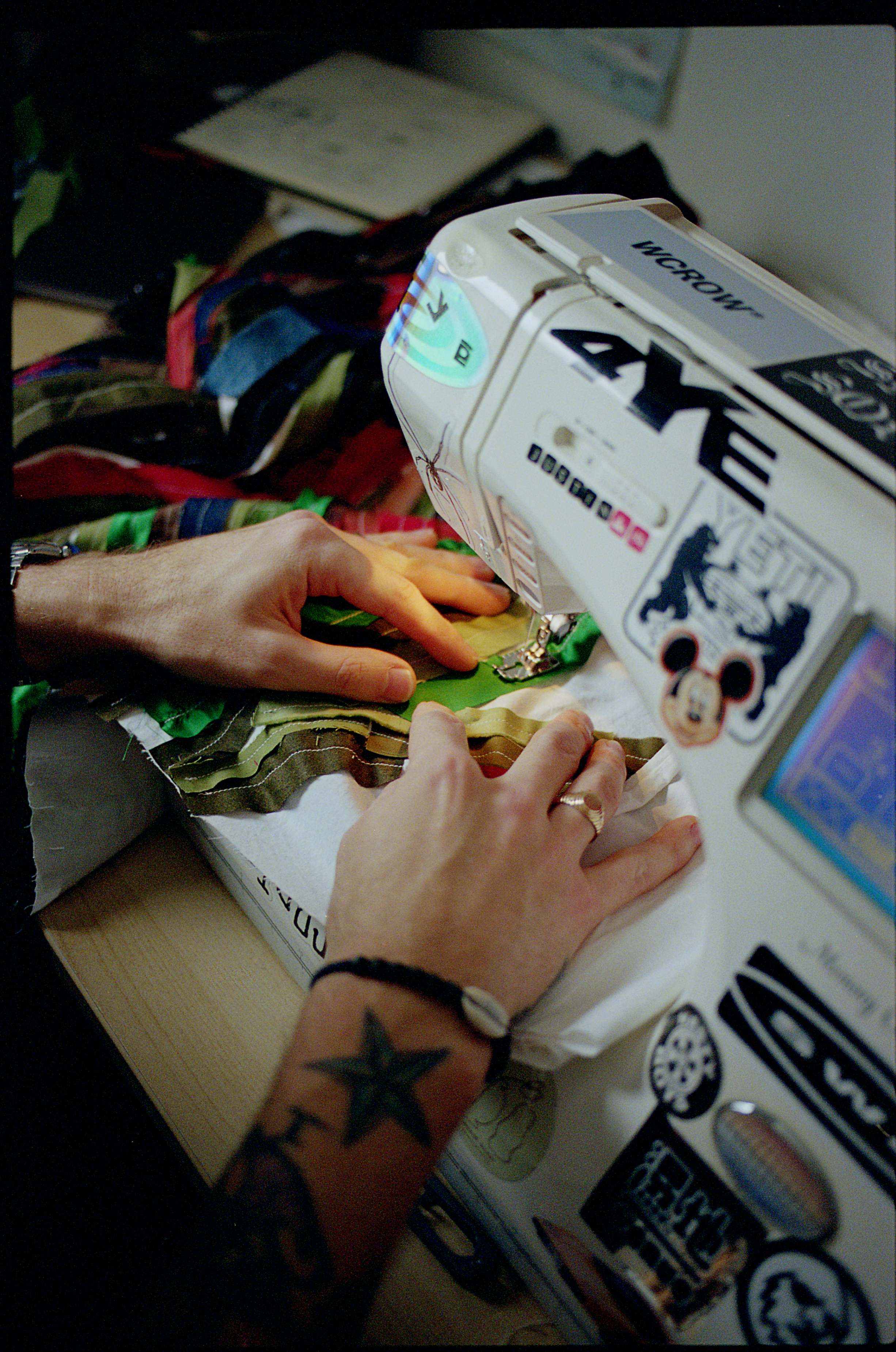
About stitching specifically?
⎯⎯⎯ They would just say it’s not a quilt, it’s “fibre art”.
That’s kind of a compliment I guess.
⎯⎯⎯ I’m here for it.
Were there certain formulas that you learned when you started and subsequently subverted as you developed your own way of working?
⎯⎯⎯ It was a very experimental learning process. I essentially got all the supplies and then i would contact my mother and ask what’s next, and then she’d send me a video of her or a YouTube video of someone doing it. There’s a lot of pieces that I have that take traditional techniques and designs and push it farther. For example, I have a piece that’s a house in the middle with negative space around it. The house design is quite a traditional quilting design. I took a sheet of fabric and sewed raw strips throughout it and took that and used it as I would a normal piece of fabric. I cut the house out of that and pieced together the house so it was all these strips sewn in with clean edges where they were patched together. You’re working in this medium and paying respect to traditional designs and changing or altering them. Like taking the triangles, which are called half squares, and creating these mosaics, switching direction, mixing different sizes, and trying to create with freedom. A lot of the traditional quilts are boxed out, gridded, and perfect, so I’m taking these techniques and breaking the pattern. I like this chaos that’s contained, like inconsistent repetition. I have pieces that are checkered, but then I cut it up and mix different shapes together so that things don’t line up perfectly. It’s the mix that I enjoy. Being mixed race and having two different cultures on each side and trying to mix them together. It’s a confused process.
What does your mom think of the quilts?
⎯⎯⎯ She loves it. It’s a funny thing, because while I was learning it I would say I wanted to do certain things and she’d say “you can’t do that,” as if it wasn’t possible. Then after I do it, she’s like “that looks great.” I always say, she only likes it because I made it. If she saw this somewhere else, she’d still hink “you can’t do that.”
She’d be typing in the comments.
⎯⎯⎯ [Laughs] It’s her burner account.
Did learning to quilt reinforce your relationship with your mom?
⎯⎯⎯ I think so. It brought us closer. For both of us it lets us appreciate what the other is doing.
It’s a nice consequence of becoming interested in something your parents are interested in.
⎯⎯⎯ Then the legacy lives on. I always think of it like recipes passed down from grandmother to grandmother, and each person adds a little bit to it as time goes on.
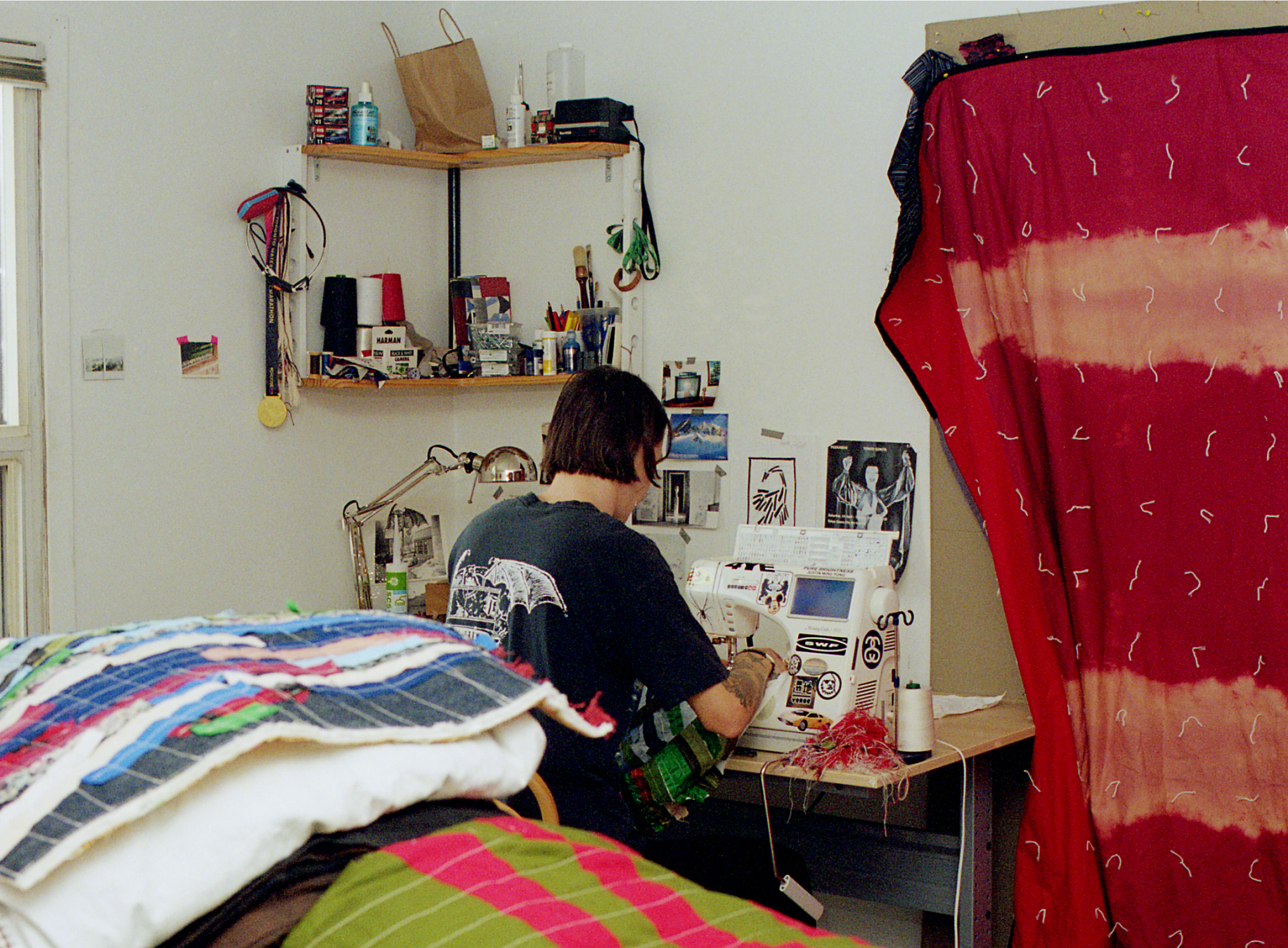
It looks like your work is breaking out of the fixed rectangle of the quilt and becoming more painterly. I’m wondering what your approach is to your new work?
⎯⎯⎯ Those are the strip pieces that I’ve been working on. It started a few years ago, but it’s become a bigger part of my practice now. Those strips are the off-cuts of the other pieces that I’ve made. I look at it like painting, the way that the fabric forms on the fabric. They are all about building off of eachother. One of the things about making the more traditional quilts is that the edges are so harsh. Making these pieces helps soften it. I wanted to make them not so definitive. The pieces with the fraying edges, or with a slight gap, or smaller pieces in a larger format, help gradate those edges. It just comes back to working with what you have. I’ve never thrown away any off-cuts, so they all have this relationship with each other. With painting you can create whatever colour you want. I don’t want that. I want to find the swatches and fabrics that exist and build relationships from them.
– East Room is a shared workspace company providing design-forward office solutions, authentic programming and a diverse community to established companies and enterprising freelancers. We explore art, design, music, and entrepreneurship. Visit ournews & storiespage to read more.